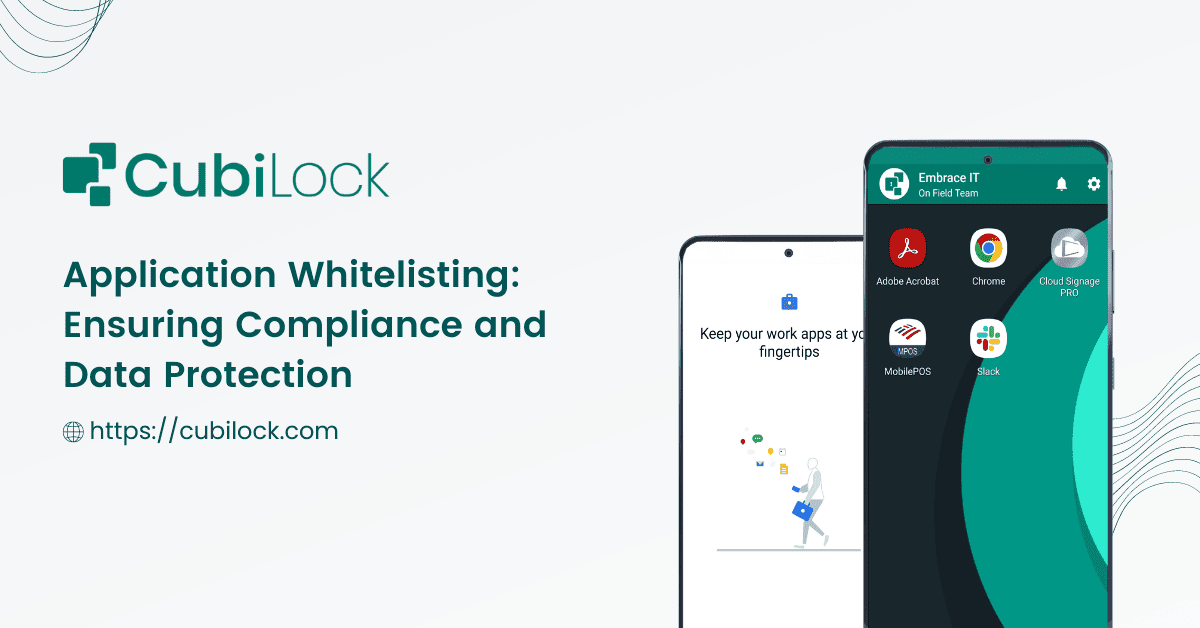Application Whitelisting: Ensuring Compliance and Data Protection
- February 9, 2024

Data protection is a top priority for organizations across industries. With the proliferation of cyber threats and the increasing stringency of data protection regulations, businesses face significant challenges in safeguarding sensitive information and ensuring compliance with regulatory requirements. Application whitelisting emerges as a powerful cybersecurity measure that not only enhances data protection but also plays a crucial role in achieving compliance with data protection regulations.
Understanding Application Whitelisting
Application whitelisting is a proactive security approach that allows only approved applications to execute on a system or network while blocking unauthorized software from running. Unlike traditional antivirus solutions that rely on blacklisting known threats, whitelisting focuses on permitting only trusted applications, thereby significantly reducing the attack surface and mitigating the risks associated with unapproved software.
Various data protection regulations worldwide impose stringent requirements on organizations to protect personal and sensitive information from unauthorized access, disclosure, or alteration. These regulations include the General Data Protection Regulation (GDPR) in the European Union, the Health Insurance Portability and Accountability Act (HIPAA) in the United States, and the Personal Data Protection Act (PDPA) in Singapore, among others. Compliance with these regulations is not only a legal obligation but also essential for maintaining customer trust and mitigating reputational risks associated with data breaches.
The Role of Application Whitelisting in Regulatory Compliance
Application whitelisting plays a pivotal role in helping organizations achieve compliance with data protection regulations in the following ways:
Ensuring Data Integrity:
By allowing only approved applications to run, whitelisting helps maintain the integrity of critical systems and data repositories. This prevents unauthorized software from accessing or modifying sensitive information, thus reducing the risk of data breaches and unauthorized access.
Preventing Unauthorized Access:
Unauthorized applications, including malware and ransomware, pose a significant threat to data security. Application whitelisting acts as a barrier against such threats by blocking the execution of unapproved software, thereby thwarting potential cyber attacks and unauthorized access attempts. IT admins can whitelist applications on multiple devices with a kiosk lockdown solution.
Facilitating Audits and Reporting:
Regulatory compliance often requires organizations to demonstrate effective security measures and provide comprehensive audit trails. Application whitelisting enables organizations to maintain detailed records of approved applications and their activities, facilitating compliance audits and regulatory reporting.
Enhancing Incident Response Capabilities:
In the event of a security incident or data breach, timely detection and response are crucial. Application whitelisting enhances incident response capabilities by enabling organizations to quickly identify unauthorized applications and take appropriate remedial actions to contain and mitigate the impact of security incidents.
Application Whitelisting with MDM Solutions
Mobile Device Management (MDM) solutions play a crucial role in managing and securing mobile devices within organizations. When integrated with application whitelisting capabilities, MDM solutions offer enhanced control and security measures, ensuring that only approved applications can run on managed devices. This synergy between MDM and application whitelisting is essential for strengthening mobile security and achieving compliance with data protection regulations.
Enhanced Control and Compliance
MDM solutions provide administrators with centralized control over mobile devices, allowing them to enforce security policies, configure device settings, and manage application deployments. By integrating application whitelisting functionality into MDM platforms, organizations can ensure that only trusted and approved applications are allowed to run on managed devices. This granular control helps mitigate the risks associated with unauthorized software and ensures compliance with data protection regulations.
Streamlined Application Management
Application whitelisting with MDM solutions streamlines the management of applications across a diverse fleet of mobile devices. Administrators can create and maintain a whitelist of approved applications, specifying which apps are allowed to run on managed devices. This approach simplifies the application deployment process, reduces the burden on IT teams, and ensures consistency in application usage across the organization.
Enhanced Security
The integration of application whitelisting with MDM solutions enhances mobile security by minimizing the attack surface and reducing the risk of malware infections and data breaches. By allowing only approved applications to run, organizations can prevent unauthorized software from compromising the integrity of mobile devices and accessing sensitive data. This proactive security measure helps safeguard corporate assets and mitigates the potential impact of security incidents.
Improved User Experience
Application whitelisting with MDM solutions contributes to a positive user experience by ensuring that employees have access to the necessary applications while maintaining security and compliance requirements. By pre-approving essential business applications and blocking unauthorized software, organizations can strike a balance between productivity and security, empowering users to work efficiently without compromising data protection.
Compliance with Data Protection Regulations
In the context of data protection regulations such as GDPR, HIPAA, and PDPA, the integration of application whitelisting with MDM solutions is instrumental in achieving compliance. By enforcing strict control over application usage and ensuring the integrity of managed devices, organizations can demonstrate their commitment to protecting sensitive information and complying with regulatory requirements. This proactive approach to mobile security helps mitigate the risk of non-compliance penalties and reputational damage associated with data breaches.
Case Studies and Practical Examples
Numerous organizations across various industries have successfully implemented application whitelisting with MDM solutions to enhance mobile security and achieve compliance with data protection regulations. For example, a financial services firm deployed MDM with application whitelisting capabilities to secure mobile devices used by employees to access sensitive customer data. By enforcing strict control over application usage, the organization minimized the risk of data breaches and ensured compliance with regulatory requirements.
Application whitelisting with MDM solutions offers a powerful approach to strengthening mobile security and achieving compliance with data protection regulations. By integrating whitelisting capabilities into MDM platforms, organizations can enforce strict control over application usage, minimize security risks, and safeguard sensitive information on managed devices. As the use of mobile devices continues to grow in the workplace, leveraging the combined capabilities of MDM and application whitelisting is essential for maintaining a secure and compliant mobile environment.
Also read: Leverage App Whitelisting with Mobile App Management Solution
Application whitelisting serves as a critical component of an organization’s cybersecurity strategy, particularly in the context of regulatory compliance and data protection. By allowing only approved applications to run and blocking unauthorized software, whitelisting helps organizations mitigate security risks, safeguard sensitive information, and demonstrate compliance with data protection regulations. As the regulatory landscape continues to evolve and cyber threats become more sophisticated, organizations must prioritize the implementation of robust application whitelisting solutions to protect their data assets and maintain regulatory compliance in an increasingly challenging cybersecurity environment.
Device Security Analyst, loves testing devices that are used for dedicated purposes.







